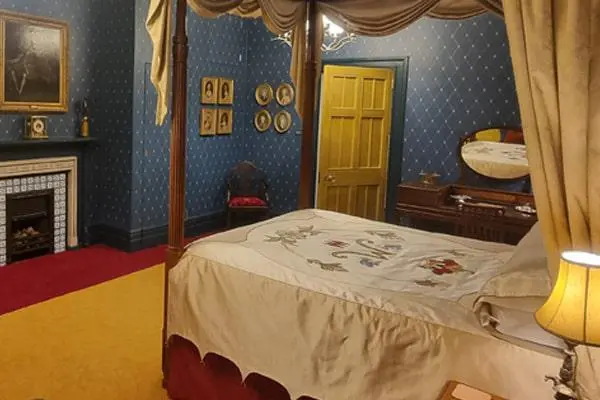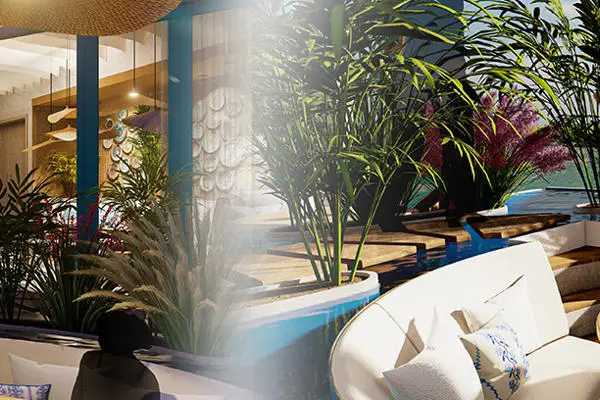
What led you to study interior design at Solent?
I’ve always had a passion for creativity and have been redecorating spaces since I was young, inspired by shows like Grand Designs. In school, at work experience with an architectural firm, I remember glancing over at the interior designer, who invited me to help her, and that experience confirmed my calling.
In college, I immersed myself in graphic design, photography, and art. However, after graduating with good grades, I initially chose the stability of a banking career. Over time, though, I began to feel a persistent sense of restlessness, an inner call toward a more creative path.
One day at work, after dealing with a series of banking complaints, I looked out the window and made the decision: it was now or never. I researched local programmes and realised that staying in the familiar was no longer an option. Taking that leap of faith transformed not just my career, but also the person I am as a designer.
What was it about Solent which made you think, ‘this is the place’?
One of the key reasons I chose their programme was the unique emphasis on the aesthetic and decorative aspects of design – not just the architectural side. Their focus on pattern and decoration made the course particularly appealing and aligned with my passion for creating beautiful spaces.
I was also born in Southampton and had established a life there with my partner. Making the decision to leave a stable corporate job and pursue a career in design was a significant risk for me, so to manage the transition I continued working at the bank to support myself financially.
At the start of my studies at Solent, my day would start at 6am. I worked a few hours, headed to lectures, then returned to work after class. Solent was incredibly supportive throughout this process.
How did lecturers support you during your course?
Their expertise, particularly in areas like photography, sewing, textiles, and computer-aided design, really enhanced the course and set us up for a range of creative avenues.
I was determined to succeed, but balancing work commitments sometimes hindered my ability to fully showcase my potential. The course leader, Lydia Southwell, emphasised that this course was my chance to make a real difference, and this conversation was the motivation I needed to take a break from work. That decision ultimately allowed me to achieve a first-class honours degree.


The support I received was invaluable. Our lecturers were active professionals within the industry, providing real-world insights that gave me hope in a field that was, and still is, quite unknown.
How did your studies prepare you for a career in the industry?
My studies were crucial in preparing me for a career in interior design. The curriculum was thoughtfully designed, combining theory with practical, hands-on experience, effectively bridging the gap between academic learning and real-world application.
In my opinion, the most effective way of teaching a creative course is by offering as much practical exposure as possible, and projects related to the industry gave me the opportunity to tackle challenges similar to those encountered in professional environments. Additionally, working on group assignments enhanced my skills in teamwork, communication and problem-solving, which are all vital in any career.
Can you tell us about your career so far?
While at university, I took a part-time job as a visual merchandiser at Marks & Spencer. This position was instrumental in developing my commercial design skills, particularly in crafting engaging window displays and in-store visuals, perfectly complementing my studies.
In my second year, I also had the incredible opportunity to appear on an interior design programme on the BBC, which three million viewers. Although I wasn’t fully prepared to share my design journey publicly at the time, the experience opened so many doors for me.
On the day I submitted my Final Major Project, my course leader emailed me about a competition in Livingetc magazine, aiming to crown the up-and-coming designer of the year. I ended up being shortlisted alongside seven others, and presented my ideas to industry figures like Sandra Rhodes, interior stylist Marianne Cotterill, and blogger Will Taylor. I still remember the thrill of being chosen as the winner, especially as the other competitors were so advanced in their craft. The prize money, alongside the opportunity to redesign a client’s home, was transformative. I reinvested the funds into a quality camera, and Marianne Cotterill later invited me to assist her, leading to several enriching experiences styling for Livingetc.
After the opportunities that followed becoming Young Interior Designer of the Year, I had a strong desire to work behind the scenes in TV as a designer and stylist. I leveraged the contacts I gained during my appearance on TV and secured a role as a stylist for a TV programme. I was so excited, but the show was cancelled by commissioners, and I was left without a job.
After a period of self-doubt, I regrouped. I launched my website, reached out to magazines, and secured a project with a private client. Soon after, the production company contacted me about a new show, inviting me to be the designer. This marked the start of my TV journey, leading me to work on set design and home makeover shows alongside industry icons such as Sarah Beeny, Amanda Lamb, and Lawrence Llewelyn-Bowen. I have also styled for TUI, travelling across Europe with their media team to style hotel shoots for TV adverts and marketing.
In 2021, I decided to slow down slightly and base myself in my own studio, taking the time to reasses my direction following the disruptions caused by the pandemic. Since then, the response to my private residential projects has been overwhelming. My portfolio has grown to include a villa in Greece, the family home of Katie Piper, an indoor pool, and a bar entertainment space.
What kind of challenges did you experience at the start of your career, and what would your advice be for overcoming them?
Starting out as an interior designer came with its challenges, but each was an opportunity for growth. One of the biggest hurdles is building credibility and experience in a competitive field. Without an established portfolio, gaining client trust can be difficult. Many newcomers start with small projects, internships, or freelance work to showcase their skills.
Another challenge is establishing a strong network and personal brand. The industry thrives on connections, and it takes times to build relationships with clients, contractors and suppliers. Attending events, joining professional groups, and leveraging social media can help increase visibility.
Understanding the business side of design is also crucial. Pricing, contracts, project management, and client communication are just as important as creativity. Many new designers struggle with these aspects but can develop them through mentorship and hands-on experience.
What does a typical working day look like for you?
Currently, my work involves a dynamic mix of designing, sourcing, and project management, ensuring each project progresses smoothly from concept to completion.
A typical day often begins with design work, whether that’s developing mood boards and refining layouts or collaborating with clients to bring their vision to life. I dedicate time to researching materials, colour palettes, and emerging design trends to ensure my concepts are innovative and fresh.
Sourcing is another key aspect of my role, liaising with suppliers and manufactures to select the best furnishings, finishes and decor elements that align with the client’s aesthetic and budget. I often visit showrooms, compare materials, and negotiate with vendors to secure the most suitable options. Project management is equally important, requiring close coordination with contractors, architects and other professionals to ensure deadlines are met.
Each day is a balance of creativity, organisation and collaboration, making the role both dynamic and rewarding. It’s this blend of artistic vision and practical execution that makes interior design such an exciting and fulfilling profession.
And, finally, what advice do you have for someone wanting to become an interior designer?
- Build a strong foundation! Study interior design or a related field, but also explore subjects like fine art, architecture, or graphic design to develop a well-rounded creative eye.
- Develop your portfolio! Start early by taking on small projects, experimenting with personal designs, or even redesigning rooms at home. A strong, diverse portfolio is key to standing out.
- Gain hands- on experience! Seek internships, apprenticeships, or part-time roles with design firms, showrooms or home staging businesses. Real-world exposure is invaluable.
- Master the digital tools! Learning industry-standard software like SketchUp, AutoCAD, Adobe Creative Suite, and 3D rendering programmes to bring your ideas to life.
- Network and stay inspired! Attend design events, connect with industry professionals, and follow designers you admire. Building relationships can open doors to opportunities.
- Understand the business side! Interior design isn’t just about creativity; budgeting, project management, and client communications are equally important skills.
- Stay curious and adaptable! Trends evolve, and so does the industry. Keep learning, researching, and refining your skills to remain competitive in the field













